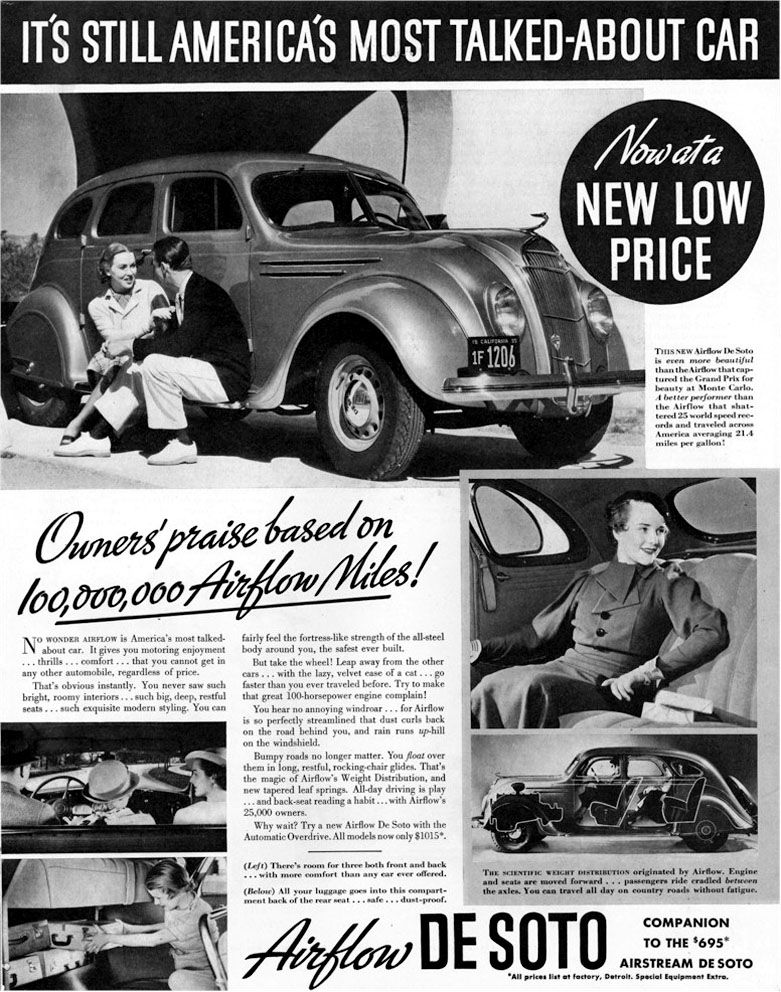Those are the last words written about DeSoto in standard catalog of® American Cars 1946-1975 by John Gunnell. In fact, those are the only words written in the Historical Footnotes section for the 1961 model year.
On this day in 1960 Chrysler announced it was discontinuing the DeSoto. Apparently dealers received the news via telegram. The announcement came just 47 days after the 1961 model year cars were introduced. A year before, Ford had done a similar thing regarding the Edsel in that the company announced it was discontinuing the car just five weeks after introducing 1960 model year cars.
In 1928 Walter Chrysler purchased the Dodge Brothers company as well as introduced the Plymouth and DeSoto. That’s a lot for a decade let alone for one year.
DeSoto’s niche was supposed to be the medium-priced bridge between Chrysler and Dodge. As such, DeSoto produced Airflow models like Chrysler; Dodge did not offer such models. The Airflow was a radical design for its time (introduced in 1934). It was probably the first full-size American production car that emphasized aerodynamics as the basis for body style. Also, the engine was moved forward—over the front wheels—and the passengers were moved forward as well so that the rear passengers were seated within the wheelbase and not on the rear axle. However, whereas Chrysler offered more conventional cars along with the Airflow in 1934, DeSoto did not and saw sales sink dramatically even given the context of the time: from 23,000 cars sold in 1933 to 14,000 in 1934. From this article on motorcities.org comes this ad for the DeSoto Airflow:

As the ad says DeSoto did release a companion to the Airflow, the Airstream, in 1935 and the Airstream was a more conventional car. The new model helped DeSoto sales increase to about 27,000, or nearly twice that of 1934. (No, this is not going to be a year-by-year history of DeSoto. You can take a deep breath.)
In 1942 DeSoto became just the second American auto maker to produce a car with hidden headlights. (Cord had produced such a car in 1936-37, the legendary 810/812.) These headlights were called Air-Foil lights and the slogan was “Out of Sight Except at Night.”

From Wikipedia and Steve Brown of Ann Arbor, Michigan (USA) is, obviously, a picture of a 1942 DeSoto with the hidden headlights.
In the 1950s DeSoto was a part of the horsepower race and, as such, offered a version of the first Chrysler hemi V-8 although its first hemi offering was smaller than the Chrysler 331 hemi (DeSoto’s was 276 cubic inches) and it wasn’t offered until a year after Chrysler. It is this vintage of DeSoto that really floats my boat.
I have shown this picture before; from en.wheelsage.org what I consider to be the ultimate DeSoto: a 1956 Fireflite Sportsman. This car is a longshot contender for Ultimate Garage 2.0.

A DeSoto was the pace car for the Indianapolis 500 in 1956; five years later, the make did not exist.
With the Chrysler Corporation moving Imperial to its own make, the Chrysler make began to move down the price spectrum into the space supposed to be occupied by DeSoto. Dodge began to creep up into DeSoto’s space as well. Of course, these decisions were made by the company so maybe the DeSoto was “supposed” to be phased out. The severe recession of 1957-58 really hurt DeSoto; sales plummeted from 127,000 in 1957 to just 49,000 in 1958. Supposedly the cars also acquired a reputation for poor quality around this time as well. Who knows what came first, though?
Rumors that DeSoto would be eliminated began appearing around 1959 and those rumors, like the ones that would soon plague Studebaker, became a self-fulfilling prophecy. Despite a rebound in the US economy (US GDP grew by nearly 6% in 1959) DeSoto production declined to 46,000 for the 1959 model year. Sales for 1960 evaporated to 26,000 and the DeSoto was no more by the end of the calendar year.
As I have written so many times that regular readers are, no doubt, very tired of reading it, fewer car companies means fewer sources of innovation for styling and for engineering. Today’s automobiles are very safe and very reliable compared to those of generations past, but the cars have a disturbing sameness. From my perspective, I think almost all SUVs and pickup trucks also look very similar to each other. I think we automobile enthusiasts should always remember the cars that have gone before.
Good-Bye DeSoto!
#somanycarsjustonelife
#disaffectedmusings
DeSoto for Chrysler was much like Mercury was for Ford – their corporate parents vacillated on what the car should be, depriving it of making its own niche in the marketplace. Neither Mercury nor DeSoto ever enjoyed the well-defined role in the corporate structure that Buick and Oldsmobile enjoyed at GM – until the bean counters took over GM and ruined Oldsmobile.
LikeLike
I assume you’re familiar with Bob Lutz’s book, Car Guys vs Bean Counters.
LikeLike